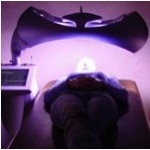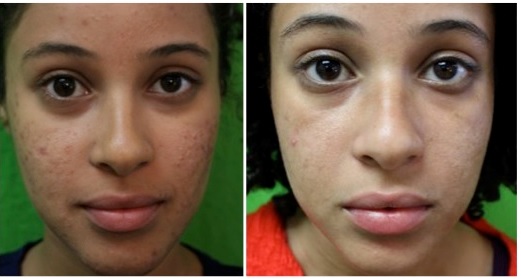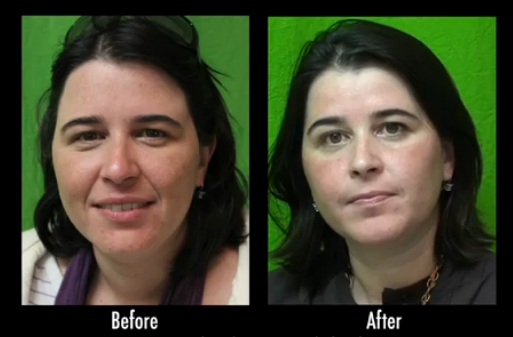Chronic acne can be difficult to manage on your own. For example, you may notice that products do not help. And even if you wash your face more frequently than most other people, you may still see pimples.
Causes of Acne
Many people think that acne is caused by dirt and makeup getting stuck in the pores. However, many individuals have stubborn forms of acne. This is often due to more complicated issues beneath the skin. This can include highly active oil glands, hormones, and the skin’s frequent production of cellular debris. All these issues can lead to regularly blocked pores.
(1) Hormones
Hormonal surges and imbalances can occur throughout a person’s life. They are the main reason why acne issues may continue into adulthood.
Causes of hormonal fluctuations include:
- Pregnancy
- Menopause
- Cushing’s Syndrome
- Polycystic Ovary Syndrome
Hormones will trigger the sebaceous glands to become larger and secrete more oil. There are two types which have this effect:
- androgens
- testosterone
- Dehydroepiandrosterone sulfate (DHEAS)
- dehydrotestosterone
- Insulin growth factor (IGF-1)
The release of IGF-1 is triggered by an increase in a person’s glycemic index, due to the dietary consumption of sugar and carbohydrates. The body reacts by producing more insulin. And this in turn stimulates the production of IGF-1
(2) Hyperkeratization
Hyperkeratization refers to a condition which affects the inner lining of the hair follicle. Cells here normally slough off and leave the follicle as a result of hair growth. However, individuals may produce higher levels of keratin. And this causes the dead skin cells to clump and block the skin pore.
(3) Genes
A person’s genetics can predispose them to the physiological conditions which lead to the development of acne. This is evident in family histories. In cases where acne seems to be inherited, there are usually a larger number of lesions as well as an earlier onset than average.
(4) Stress
Research does support a relationship between acne and stress. This is recognized by the National Institute of Health. Also a study of teenagers in Singapore revealed a high correlation between acne and stress.
When Do You Need To See A Dermatologist For Acne?
It is important to get help from a doctor right away to prevent inflammation and scarring. Here are a few symptoms to look out for:
1) Little to no results from over the counter creams, cleansers and pore strips
2) Redness on your skin
3) Presence of pus and discharge
4) Soreness in your pimples
Different physiological causes are probably responsible for these occurrences. Real improvement can only be experienced by thoroughly targeting the factors.
Acne Types
The two general categories of acne can be summed up as:
- non-inflammatory
- inflammatory
Non-inflammatory acne lesions may develop due to simple blockages within the skin. However, the buildup of oil beneath the skin creates a prime environment for the proliferation of the P.acnes bacteria. In response to this, the immune system will launch attacks to get rid of foreign organisms. White blood cells are sent to the affected acne lesions. And this is what creates inflammation to occur.
Besides the different types of acne conditions, there are also different forms of acne pimples. Here is a basic list:
- Papules – pink bumps (lesions)
- Pustules – the typical average pimple
- Comodones – acne lesions that form when hair follicles become filled with oil and bacteria
- Nodules – sore, painful pimples
- Cystic lesions – deep lesions filled with pus which have developed
- from inflammation. The hair follicle becomes ruptured.
Acne Treatment
Dr. U will determine the safest and most effective form of treatment for each individual patient. This is typically determined by identifying the specific causes which contribute to a condition.
There is often more to acne than just blocked skin pores. In fact, with extremely stubborn cases, there are often multiple issues at work. These include:
- internal sloughing of skin cells which create very deeply embedded pore blockages
- bacterial proliferation which leads to inflammatory responses
- hormonal surges which enlarge the size of the sebaceous glands, causing the release of more oil as well as frequent pore blockages.
One of the options that patients have at our office is to choose lasers and light based therapies which utilize energy wavelengths to achieve very specific and targeted objectives below the skin’s surface.
(1) Photodynamic Treatment For Acne
Photodynamic treatment for acne may be the best option for patients who have very busy schedules and cannot keep up with the application of creams, lotions and cleansers. It is very safe and effective.
The central mechanism of action is to target bacteria. Microbes will cause inflammation which narrows the skin pore opening and traps oil. Light waves in the range of 405-420 nm are used to initiate oxidation reactions within these organisms, leading to their self destruction. This form of treatment can reduce acne lesions by as much as 64-76%
As a side note, photodynamic treatments can also address other skin issues such as:
- actinic keratosis
- warts
- photodamage from sun exposure
Clear Light 100 for Photodynamic Acne Treatment
Clear Light 100 uses a Selective Photo Clearing (SPC*) technology. Multiple light wavelengths work to destroy bacteria within the skin which contributes to acne and inflammation.
Clear Light 100 is capable of reducing and or eliminating up to 70% of inflammatory lesions. The amount of time this takes is often less than a third of the time required by more traditional methods. Furthermore, it does not result in hyperpigmentation, burns, scarring or hair loss that can result from pulsed light treatments.
(2) Laser
The Spectra laser system uses a single wavelength (1060nm) which can safely be used for all skin tones. It is able to unblock deeply embedded pores, eliminate microbes and burn away the outer sac of highly active sebaceous glands so that they secrete less oil. Patients are able to then achieve major milestones in the clearing and improvement of their skin.
In patient cases where the skin has become very red due to acne, the use of the Vbeam laser may be used to eliminate tiny surface blood vessels to help restore normal coloration as well as address blockages, bacteria and excess oil secretion.
(3) Combination of Vbeam and Blu Light
The Office of Dr. U also offers treatment programs which combine the use of photodynamic technology with laser.
The Vbeam laser (585-595nm) is used in conjunction with a photoenhancing lotion known as Levulan. This lotion enables the skin to absorb more of the light energy than it would alone. Therefore the Vbeam system can do a better job of unblocking pores & killing bacteria.
This form of treatment is quite effective for cystic acne. Also, the number of sessions is reduced to one per month, whereas weekly treatments are needed for Blu Light alone.
(3) Medical Acne Treatment
Some patients may benefit from the use of medical drug treatment for their acne condition. This may be the case when there are very extreme physiological imbalances contributing to challenging lesions. Examples may include:
- high rates of desquamation (shedding of cells) within the lining of the hair follicle
- high concentration of androgens in the blood
Patients must be aware that there is a much higher risk of dangerous side effects and complications with the use of drugs. But this option may be resorted to as a last measure if other forms of treatment have failed.
Medical treatment for acne often includes the following categories
Hormone treatments
This involves the use of oral contraceptives to lower the concentration of androgen hormones and reduce the secretion of sebaceous oil.
One example includes a combination of cyproterone (an antiandrogen) and Diane 35 oestrogen
Antibiotics
Antibiotics work to counter the reproduction of bacteria beneath the skin. These drugs should only be reserved for very severe forms of acne since microbes can develop resistance to antibiotics.
Examples of antibiotics used to treat acne include:
- Clindamycin
- Erythromycin
- Tetracycline
Oral Retinoids
These drugs may be used for cystic acne. They work to reduce oil secretion. However, these medications are highly toxic. And patients must be aware of their risks prior to committing to a treatment program.
Isotretinoin (a derivative of Vitamin A) is an example of an oral retinoid. It works by reducing the secretion of oil. Brand name versions of this drug include:
- Accutane
- Claravis
- Sotret
- Amnesteem
Oral retinoids may be considered as a last resort treatment for acne in extreme cases where other therapies have failed. These drugs entail the risk of multiple side effects which include birth defects (in women).
Female patients who have the potential to bear children and choose to take isotretinoin are required by law to enroll in the iPledge program. This is a computerized system designed to prevent birth defects. It requires the compliance of doctors and pharmacists as well as the patient. Individuals in this program must submit blood tests and undergo monthly pregnancy screenings
Topical Retinoids
Topical retinoids work to regulate the life cycle and shedding of skin cells. Therefore, they may be resorted to in cases where desquamation is a central cause of patient’s acne issue.
Examples include:
- tretinoin (Retin A)
- adapaline (Differin)
- tazarotene (tazorac)
Benzoyl Peroxide
Benzoyl peroxide is available as gels, creams, lotions and cleansers. It may be recommended for mild to moderate cases. This compound works topically to reduce bacteria. Unlike antibiotics, there is no risk of these microbes developing a resistance. It can also help dislodge blockages closer to the skin’s surface by causing the outer layers to peel.
Benzoyl Peroxide is known to be quite effective for acne at concentration levels of 2.5%, 5.0% and 10%.
Monitoring Acne Treatment Progress
The Office of Dr. U is committed to helping patients experience excellent results. We have a state of the art digital skin imaging technology called VISIA. Specific parameters of the skin (e.g. presence of bacteria, skin texture etc.) are measured before and after treatment. Results are calculated as percentiles, comparing individual patients to the data of other similar individuals within their age and ethnic group. With this capability, patients are able to actually see a quantitative and objective view of their progress.
The Office of Dr. U offers the VISIA skin analysis on a complimentary basis for our patients.
Patient Photos
Helping you experience real improvements is always a priority for us.
At Fine Touch Dermatology, we offer highly effective methods to help patients get the results they want and achieve clearer skin. Here are two of our patients who received excellent outcomes from laser treatments:
Patient Videos
Here, Dr. U. discusses how severe acne can be treated safely without the risk of harmful side effects from prescription drugs.
Related Posts
- A Young Woman in Los Angeles: Acne Lasers Changed My Life
- Why Laser May Be the Best Treatment For Acne
- Tackling Acne and Scarring In Adults
- Options for Removing Acne and Reducing Acne Scars
- Laser Results For Diminishing Severe Acne on Patient
- Treatment For Severe Nodulocystic Acne and Removal of Acne Scars
- What Cameron Diaz Has To Say About Acne In Her Book
- Which Celebrities Have Had To Battle Acne?
- Does Acne Get Worse With Less Sun In The Winter?
- Why Pregnancy Is Still Occurring In Women On the iPledge Acne Program
- Acne Causes and Options For Better Skin
- Dealing with Acne: What Are These Ingredients in My Face Wash?
- The Results of Celebrity Endorsed Acne Products
- Acne And Weight Gain In Young Women
- The Emotional Experience of the Acne and Choosing Treatments Wisely
- Dermatology Today: Improving Acne With Lasers
- Spectra and Fraxel Dual For Acne and Scars
- Results of Acne and Facial Scar Removal For Los Angeles Patient
- Reducing Acne with Clear-100 Selective Photo Clearing (SPC)
Complimentary Consultations
Individuals who are interested in advanced acne treatments are welcome to sign up for a no cost consultation. During these sessions, prospective patients can ask questions and learn about the most effective treatment options for long term improvement.
To schedule an appointment at our Redondo Beach location, you may start by filling our our online consultation form at the top of the page. Also, we can be reached at 877-337-6424.



